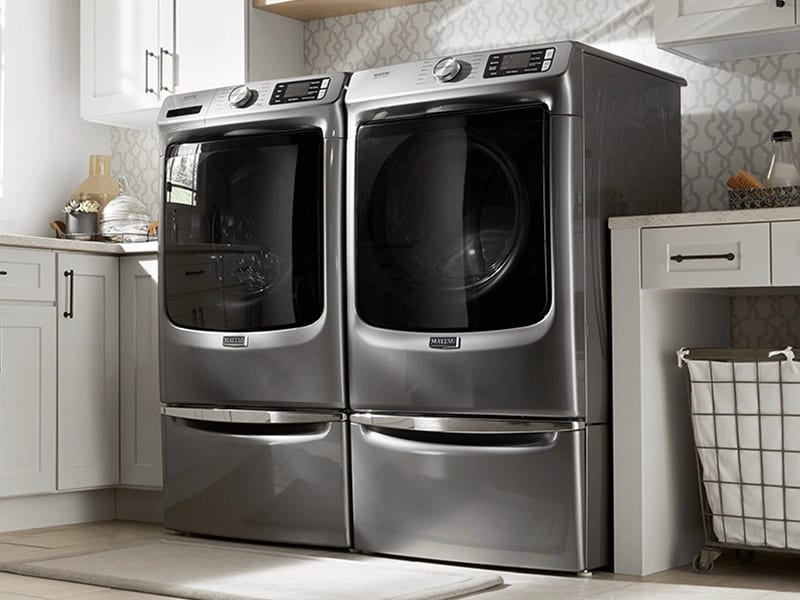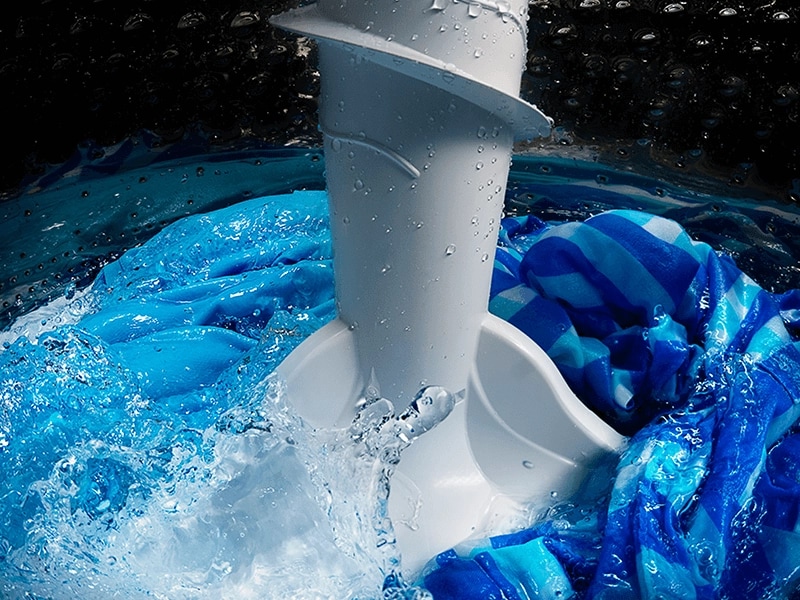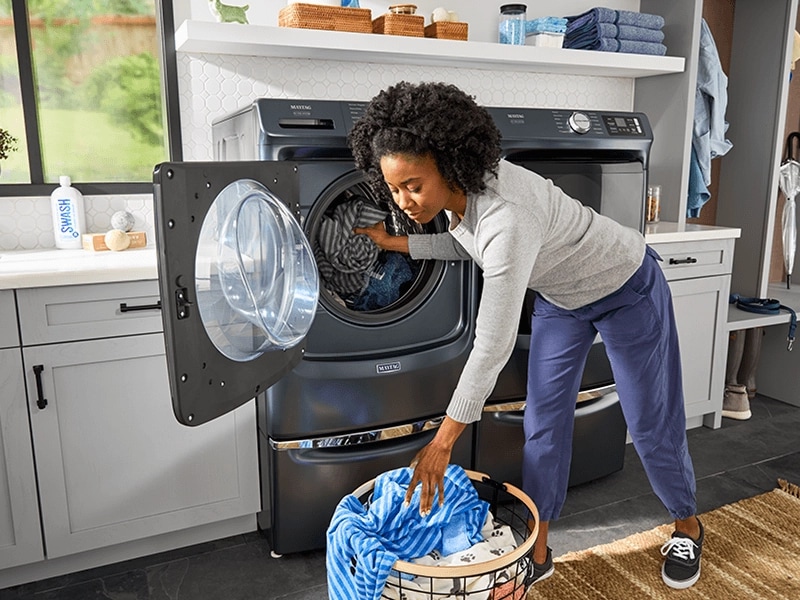
HOW TO LEVEL A WASHING MACHINE
A level washing machine is essential for optimal performance, reduced noise and vibration. Whether you have a top load or front load washer, proper leveling helps ensure your appliance operates smoothly. This guide will walk you through the process of leveling your washing machine, providing clear instructions for both top load and front load models.
WHY LEVELING YOUR WASHING MACHINE IS IMPORTANT
Before diving right into how to level a washing machine, it’s important to understand why a level washing machine matters. An unlevel washing machine can potentially lead to:
Excessive vibration and noise during operation
Uneven distribution of clothes during the wash cycle
Potential damage to the machine's internal components
Increased wear and tear on the appliance
Reduced efficiency and performance
Water can splash off the top of the basket or the load if unlevel
Leveling your washing machine is a simple, yet crucial maintenance task that can possibly extend the life of your appliance and may also improve its performance. It's also a key step when installing top load washers or front load models. Always check your user guide first, as the processes below are general and your make/model of washer might include different instructions.
HOW TO LEVEL A TOP LOAD WASHER
When leveling a top load washer, use a wrench or pliers to adjust the feet until the unit is level. Because of the weight of a washing machine, you should always get another person to help you when adjusting or moving it. Once again, be sure to check your user guide first for more specific instructions.
NOTE: These instructions are only intended to supplement your written installation instructions that came with your washer. Please refer to your installation instructions as exact instructions can vary by make and model.
WHAT YOU’LL NEED: SUPPLIES AND TOOLS
To level your washing machine, gather the following tools:
Carpenter's level or smartphone level app
9/16” or 14mm open-end or adjustable wrench or pliers (depending on your model)
Work gloves
Wooden blocks or shims (optional)
WARNING: Excessive Weight Hazard
Use two or more people to move and install your washer. Failure to do so can result in back or other injury.
STEP 1: POSITION THE WASHER
Place your top load washer in its intended location. Ensure there's enough space around the appliance for easy access to the leveling legs.
STEP 2: CHECK THE LEVEL
Place your carpenter's level or smartphone level app on top of the washer, first from side to side, then from front to back. If the bubble within the level doesn't center itself (or the app doesn't show level), adjustments are needed.
NOTE: The washer may be level even if all four feet are not touching the ground. To check that all feet are in contact with the ground, place your hands on opposite corners of your washer and try to rock it. If it rocks, then you’ll need to adjust the feet so they are all touching the ground. Recheck the level and adjust per the following instructions, if needed.
STEP 3: RAISE THE WASHER
With help from another person, raise the front of the washer about 4 inches and prop a wooden block or shim underneath to hold the washer in place while you work.
STEP 4: ADJUST THE FRONT LEGS
If your leveling feet are metal:
Locate the lock nuts on the front legs.
Loosen the lock nuts using an 9/16” or 14mm open-end or adjustable wrench.
Loosen the lock nuts until they are about a ½” from the cabinet.
Turn the leveling foot clockwise to lower or counterclockwise to raise the washer.
Tighten the lock nuts.
Adjust until the washer is level from side to side and front to back.
If your leveling feet are plastic:
Use adjustable pliers to turn the plastic leveling feet counterclockwise to lower the washer or clockwise to raise the washer.
- Adjust until the washer is level from side to side and front to back.
STEP 5: ADJUST THE REAR LEGS (IF APPLICABLE)
Some top load washers also have self-adjusting rear legs. To adjust them:
With help from another person, tilt the washer forward slightly (about 4 inches off the ground).
Gently set the washer back down.
The rear legs should self adjust.
If your model has manually adjustable rear legs, repeat the process from Step 3 for the back of the washer.
STEP 6: RECHECK AND LOCK
Once adjustments are complete, recheck the level in all directions. When satisfied, tighten the lock nuts against the washer's base to help prevent the legs from rotating over time. Double check that all feet touch the ground with the rocking test.
SHOP MAYTAG® TOP LOAD WASHERS
Experience powerful cleaning performance with Maytag® top load washers. With select models featuring Advanced Vibration Control™ Plus, which automatically redistributes unbalanced loads with a ball-bearing balancing ring and six-point suspension system, while advanced software adjusts and recalibrates for each load.
HOW TO LEVEL A FRONT LOAD WASHER
When leveling a front load washer that is placed directly on the floor instead of on a pedestal, use a wrench or pliers to adjust your machine’s feet so that they are level. Use a level to check your progress—from side to side and from front to back—both before and after you make your adjustments. Once again, be sure to check your user guide first for more specific instructions about your machine’s make and model, and get help whenever moving your machine.
NOTE: These instructions are only intended to supplement your written installation instructions that came with your washer. Please refer to your installation instructions as exact instructions can vary by make and model.
WHAT YOU’LL NEED: SUPPLIES AND TOOLS
To level your washing machine without a pedestal, gather the following tools:
Carpenter's level or smartphone level app
Adjustable wrench or pliers
Work gloves
WARNING: Excessive Weight Hazard
Use two or more people to move and install your washer. Failure to do so can result in back or other injury.
STEP 1: POSITION THE WASHER
Place your front load washer in its intended location, leaving enough space to access all four corners.
STEP 2: CHECK THE LEVEL
Place your level on top of the washer, checking both side to side and front to back. Note any areas that need adjustment.
NOTE: The washer may be level even if all four feet are not touching the ground. To check that all feet are in contact with the ground, place your hands on opposite corners of your washer and try to rock it. If it rocks, then you’ll need to adjust the feet so they are all touching the ground. Recheck the level and adjust per the following instructions if needed.
STEP 3: ADJUST THE LEGS
When leveling, make sure you check the adjustment of all four legs:
Have someone help you lift the front of the unit about 4 inches and brace it with a wood block or shim. Use your wrench or pliers to adjust the feet.
Turn the legs clockwise to lower or counterclockwise to raise the washer.
Adjust each leg as needed until the washer is level in all directions.
STEP 4: RECHECK AND LOCK
Double-check the level in all directions. Once level, use your pliers or wrench to securely tighten all four lock nuts against the pedestal, ensuring all feet are in firm contact with the ground.
SHOP ALL MAYTAG® FRONT LOAD WASHERS
Discover the convenience of Maytag® front load washers. With Intuitive Controls on select models that let you customize up to 35 of your own cycle combinations, you can get the right type of fabric care you need for whatever you’re washing.
HOW TO LEVEL A FRONT LOAD WASHER WITH A PEDESTAL
If your front load washer is mounted on a pedestal, your approach to leveling the machine will be slightly different. Follow the tips below to get started.
NOTE: These instructions are only intended to supplement your written installation instructions that came with your washer. Please refer to your installation instructions as exact instructions can vary by make and model.
WHAT YOU’LL NEED: SUPPLIES AND TOOLS
To level your washing machine without a pedestal, gather the following tools:
Open end wrench or pliers
Level
STEP 1: ATTACH THE PEDESTAL TO THE WASHER
Follow the installation instructions in the user manual for your washer and pedestal model to fully attach the two. This involves removing the leveling feet from the washer, since you will be using the leveling feet on the pedestal instead.
STEP 2: PUT MACHINE IN ITS FINAL LOCATION
Place your front load washer and pedestal in its intended location, leaving enough space to access all four corners.
STEP 3: CHECK THE LEVEL
Place your level on top of the washer, checking both side to side and front to back. Note any areas that need adjustment.
STEP 4: ADJUST THE FRONT LEGS
Locate the lock nuts on each leg. Loosen the lock nuts using an adjustable wrench or pliers. Turn the legs clockwise to lower or counterclockwise to raise the washer. Adjust each leg as needed until the washer is level in all directions.
STEP 5: RECHECK AND LOCK
Double-check the level in all directions. Once satisfied, tighten all lock nuts against the washer's base to help secure the legs in place.
Check if the machine is level using a level tool.
If the machine isn't level, use an open-end wrench or pliers to adjust the feet of the pedestal.
Recheck the level of the machine after adjustments.
Once the machine is level, use the open-end wrench to securely tighten all four lock nuts against the pedestal.

TIPS FOR LEVELING YOUR WASHING MACHINE
If you need more tips for how to level your washing machine, there are a few more things you can do, such as checking your floor and rechecking your machine’s levelness once in a while.
USE ANTI-VIBRATION PADS
For extra stability, especially on uneven floors, consider using anti-vibration pads under the washer's feet. These can help absorb vibrations and keep your machine level. Select washers from Maytag brand, such as this model, feature Advanced Vibration Control™ Plus, which automatically redistributes unbalanced loads with a ball-bearing balancing ring and six-point suspension system, while advanced software adjusts and recalibrates for each load.
CHECK REGULARLY
Homes can settle over time, affecting the level of your appliances. Make it a habit to check your washing machine's level a few times a year.
ADDRESS UNEVEN FLOORS
If your laundry room floor is significantly uneven, you may need to create a level surface using plywood or by addressing the subfloor, which may require professional help.
SHOP MAYTAG® WASHER AND DRYER SETS
Upgrade your laundry room with a matching Maytag® washer and dryer set. Designed to work together and look good doing it, these sets help you maximize the power of both your washer and dryer.

TROUBLESHOOTING WASHER LEVELING ISSUES
Try the following tips if you experience any hiccups in your attempts to level your washer.
WASHER STILL VIBRATES AFTER LEVELING
If your washer continues to vibrate or shake excessively after leveling, check for:
Unbalanced loads: Distribute clothes evenly in the drum.
Weak floors: Check the floor or relocate the washer to a more stable area.
Shipping bolts: Ensure all transport bolts have been removed.
If these steps don't resolve the issue, take a deeper dive into other possible reasons why your washing machine isn’t working and how to address it. And of course, if you feel like you’re in over your head, some issues are best handled by calling in professional help.
DIFFICULTY ADJUSTING LEGS
If you're struggling to turn the leveling legs on your washing machine, try these tips:
Clean the threads of any debris.
Apply a small amount of lubricant to the threads.
Use pliers for extra leverage, but be careful not to damage the legs.

FREQUENTLY ASKED QUESTIONS
Here are some of the most common questions people ask when wondering how to level a washing machine:
WHAT IS THE EASIEST WAY TO LEVEL A WASHING MACHINE?
The easiest way to level a washing machine is to use a carpenter's level or a leveling app on your smartphone placed on top of the washer. Start by adjusting one leg at a time with an adjustable wrench or pliers to make it higher or lower. Check the level of the washer in both directions: front to back and side to side. Keep making small changes until the washer is balanced and level all around. Once everything looks good, remember to tighten the lock nuts on each leg to help the washer stay in place while it runs.
HOW DO YOU FIX AN UNEVEN WASHING MACHINE?
Fix an uneven washing machine by adjusting the leveling legs, using anti-vibration pads or addressing issues with the floor beneath the appliance. For persistent issues, refer to our guide on how to stop a washing machine from shaking. It may also be as simple as redistributing your laundry load in a top load washer that is shaking or thumping. Check to make sure the load hasn’t collected on one side of the drum and if so, move items around until it is even.
DOES A WASHING MACHINE HAVE TO BE PERFECTLY LEVEL?
While perfect leveling isn't always achievable, your washing machine should be as level as possible. A slight deviation (within 1 degree) is generally acceptable. A good way to test it out is to put your hand on the machine and try to gently rock it. If it rocks on any of its legs, the feet likely need to be adjusted and made more level.
WHAT DO YOU PUT UNDER A WASHING MACHINE TO LEVEL IT?
If your flooring is slightly uneven, simply adjusting the leveling legs may be all you need to do. However if you find that the washer is still not level, you can try anti-vibration pads, rubber foot pads, or wooden shims under a washing machine to help level it.
By following these steps and tips, you can help ensure your washing machine operates at peak performance, possibly reducing noise, vibration and potential damage. Proper leveling isn't just important for washing machines. If you have other appliances that need attention, check out these guides on how to level a refrigerator or how to level a dishwasher. And if you're experiencing issues with your dryer, learn why your dryer might be squeaking and how to address it.


